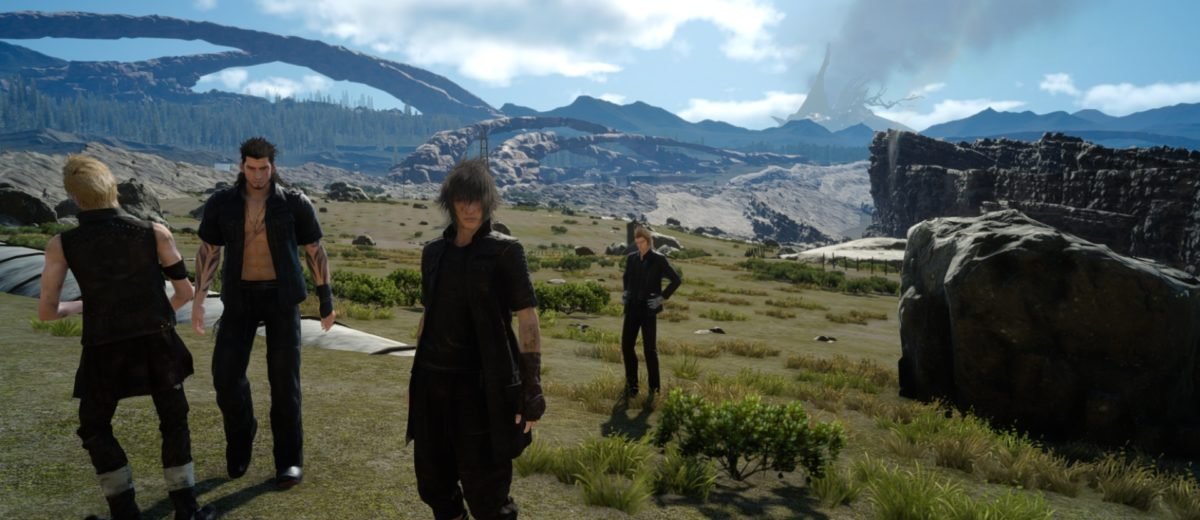Even if they all cite different games, almost every long-time Final Fantasy fan will tell you that somewhere along the way, the franchise lost a bit of its magic. With that in mind, Final Fantasy XV is Square Enix’s hail mary. It’s a sincere effort to win back old fans and catch the eye of a new generation of gamers. And though it stumbles in many ways, Final Fantasy XV still manages to come together as a beautiful, unforgettable journey, well worth the franchise name.
A globe trotting adventure across the mystical, yet modern, world of Eos, Final Fantasy XV follows Noctis, a young prince sent out on a road trip before his wedding. Eos itself is a perfect representation of the game as whole. Just as the world’s monsters, gods, and magic live alongside robots, cars, and cell phones, Final Fantasy XV is an amalgamation of influences.
There is the larger, classical narrative of warring nations, prophecies, the eternal struggle between dark and light, and even a magical crystal for good measure. But at the same time, there is the much more personal, contemporary, buddy road trip narrative of Noctis and his three bodyguards – Gladio, Ignis, and Prompto. The very same dualities pop up in every aspect of the game’s design. While Final Fantasy XV impressively keeps from buckling under the stress, the tensions between each of the distinct parts are evident all the same.
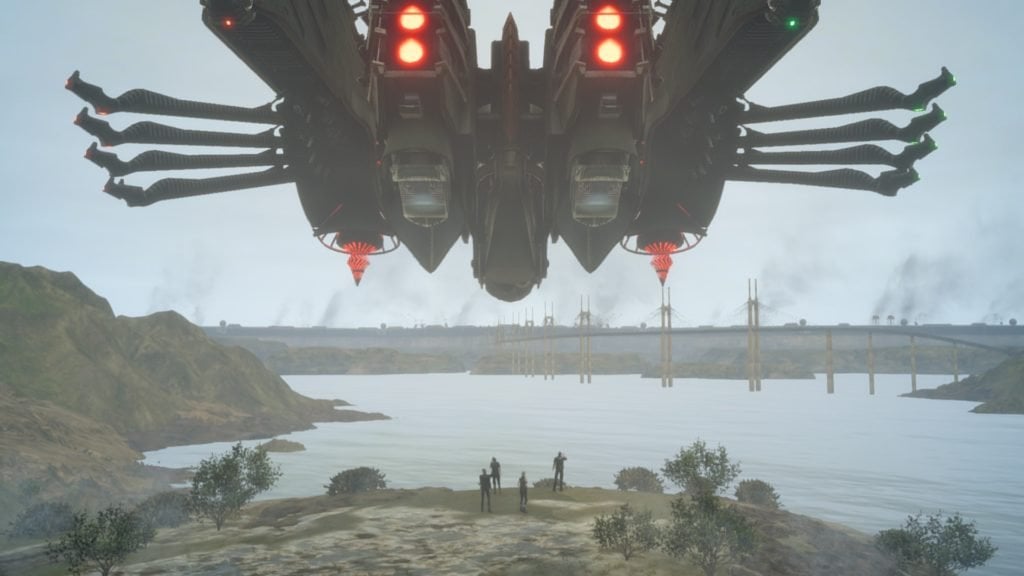
Within the game itself, the overarching story of Final Fantasy XV is not one of the best for the franchise. Originally announced as Final Fantasy Versus XIII in 2006, the game has seen its fair share of changes over the years. Couple this with the fact that elements of its story are already spread across the Brotherhood anime, the Kingsglaive film, the King’s Tale digital game, and the Platinum Demo, and you end up with a title that is far larger and more unwieldy than anyone originally intended. To its detriment, Final Fantasy XV never finds the time to adequately explain everything, leaving much of that overarching story more opaque than it should be.
Noctis is the prince of a city-state called Lucis. Due to a line of divinity passed down through the Lucian kings, it’s endured for hundreds of years, even when threatened by the growing might of the neighboring Niflheim Empire. Set to marry Lunafreya, the princess of the semi-sovereign, Niflheim-controlled province of Tenebrae, Noctis leaves his home of Crown City just as delegates from Niflheim arrive to sign a peace treaty with his father. While on the road, Noctis, Gladio, Ignis, and Prompto soon learn Niflheim betrayed the king, invaded, and sacked the city. With his father dead, and Lunafreya missing and assumed dead as well, Noctis and his friends find themselves dealing with the personal, and the surprisingly cosmic, consequences of the attack.
From there, the larger narrative moves on to include everything from vague prophecy to equally vague divine intervention and ancestral spirits. Through it all, Final Fantasy XV provides enough information to keep you engaged, but never enough to actually satisfy.

Instead, it quickly becomes clear the real focus of Final Fantasy XV is the road trip. And it’s here that the game shines brightest. Noctis’s personality is intentionally non-descript, dialogue choices allowing you to shape him as a gracious loner, a snarky jerk, or anything in between. When it comes to Gladio, Ignis, and Prompto though, their personalities explode off the screen. Gladio is a soldier at heart. Gruff, direct, and demanding, he’s the kind of friend that will tell you you’re being an idiot, even when no one else will. Ignis on the other hand is more refined. A gourmet chef, intelligent, and the most practical of the group, he takes care of everyone else, the kind of friend who actually volunteers to be the designated driver. And finally, Prompto is the fun-loving, chocobo-obsessed goofball, the glue that holds the group together.
The four friends joke and tease each other. While you run around, drive, or fight, they complain, talk about girls, and even comfort each other when needed. As well written and deep as their relationship is, it’s also just fun. Games about a group of guys going somewhere together aren’t exactly rare, but few ever capture and showcase sincere friendship, blemishes and all, in as complete or heartwarming a way. More than that though, Square Enix has shaped the mechanics of the game around the four personalities. For instance, Ignis actually is the designated driver, driving everywhere until Noctis can insist on doing it himself as the game progresses.
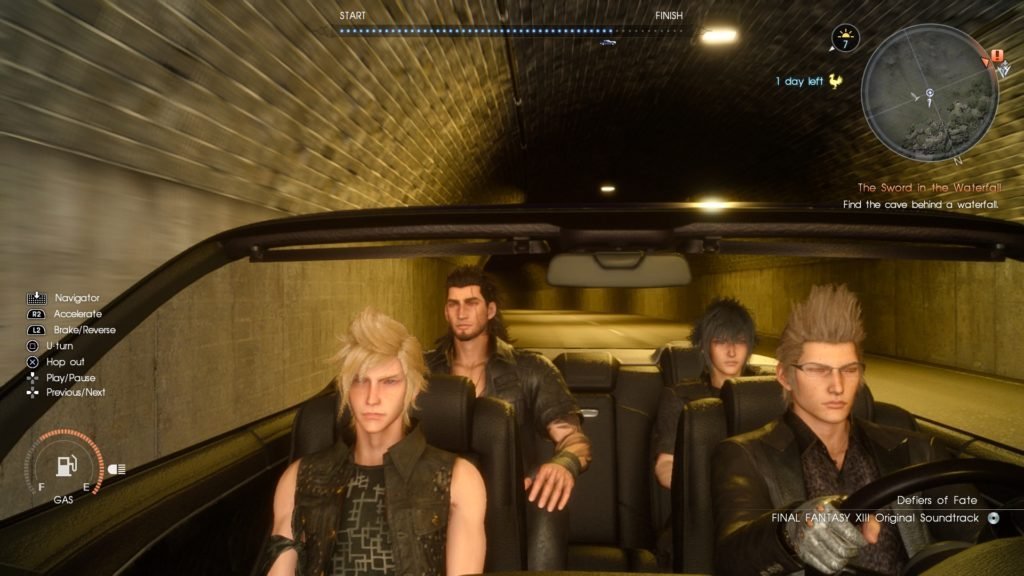
Through each of these mechanical touches, all four characters come to life more than they ever would otherwise. It’s once you begin to look at the number of ways that each system is interconnected however, that the brilliance of Final Fantasy XV comes to the foreground.
To start, each character has a specific skill that increases the more you use it. For Noctis, it’s fishing. Not only can you reel in food, you can salvage valuable items off of some of the fish that you catch. Gladio has his survivability skill, allowing him to find helpful items like potions and elixirs after each battle. Prompto takes pictures, sometimes for quests, but often for fun, allowing you to look back over them and pick your favorites. And finally, for Ignis, it’s his cooking. You discover recipes from finding new ingredients as you explore, buying the rare cookbook if you find a vendor with one, and through directly leveling up Ignis’s cooking skill. That then becomes part of the game’s unique leveling system.
Nearly everything you do in Final Fantasy XV gives you experience. That experience is banked as you play, but is not tallied and applied to your characters until you rest. If you stop at a campsite, your experience is counted in full and you can use your collected ingredients and recipes to have Ignis cook a meal. These meals each pack their own unique status-boosts for the next day. If you choose to forgo the personally cooked meal however, you can stay at various trailers, motels, or even a resort. Each costs money, but each also adds a multiplier to your banked experience when it’s tallied, the most expensive options doubling your total.
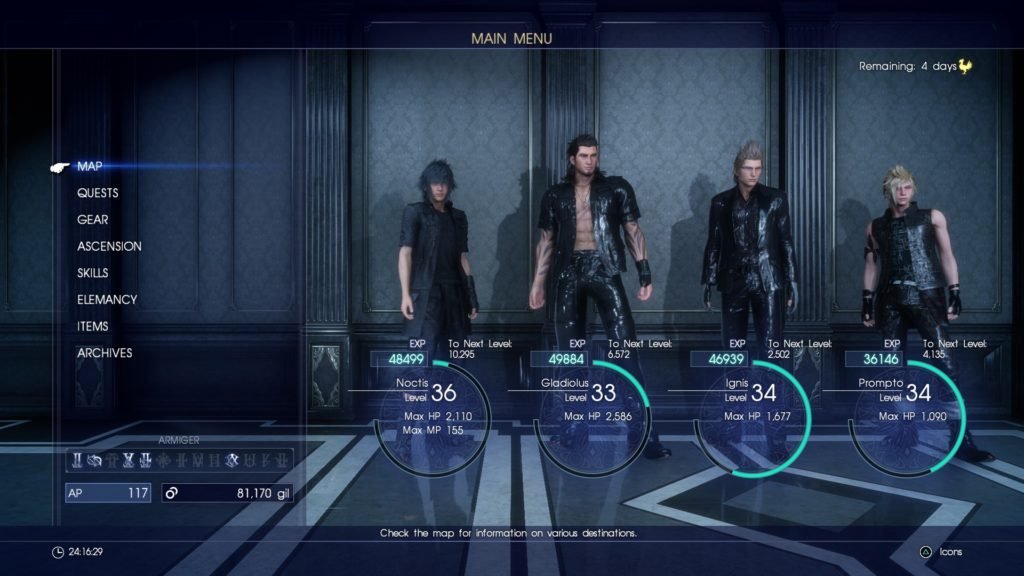
The entire system becomes an interesting question hovering in the back of your mind. The game’s day/night cycle works much like Minecraft in that the worst monsters come out at night, but there is no wait mechanic allowing you to easily skip to the next morning. Instead you have to find a place to rest. Do you find a campsite and grab a status-boost? Do you spend the money and grab a nice multiplier for what you have? Or do you save your money and stay out during the night, continuing to gain experience in order to turn it all in at once with a high multiplier?
Just as Final Fantasy XV contains hallmarks of a classic JRPG story alongside elements of something new, it’s also a blending of eastern and western design. The combination is largely what makes the game so unique, affecting everything from combat to the world map. And while the game does adopt what many would argue are the strengths of western RPGs, it unfortunately also takes on more than a few of their weaknesses.
Surprisingly, one of the better aspects of Final Fantasy XV is its combat. Aside from movement and locking on, the basics of the real-time combat system only require three main buttons. You hold one button to attack. Every sword swing, somersault, and fancy spin Noctis does, happens automatically while that button is held. You hold another button to dodge and block. As with attacking, everything happens automatically, each dodge costing a small amount of MP (Magical Points). And finally, the last button allows Noctis to warp across the battlefield, either to higher ground, instantly replenishing his MP, or directly to an enemy, dealing more damage the further away you start.
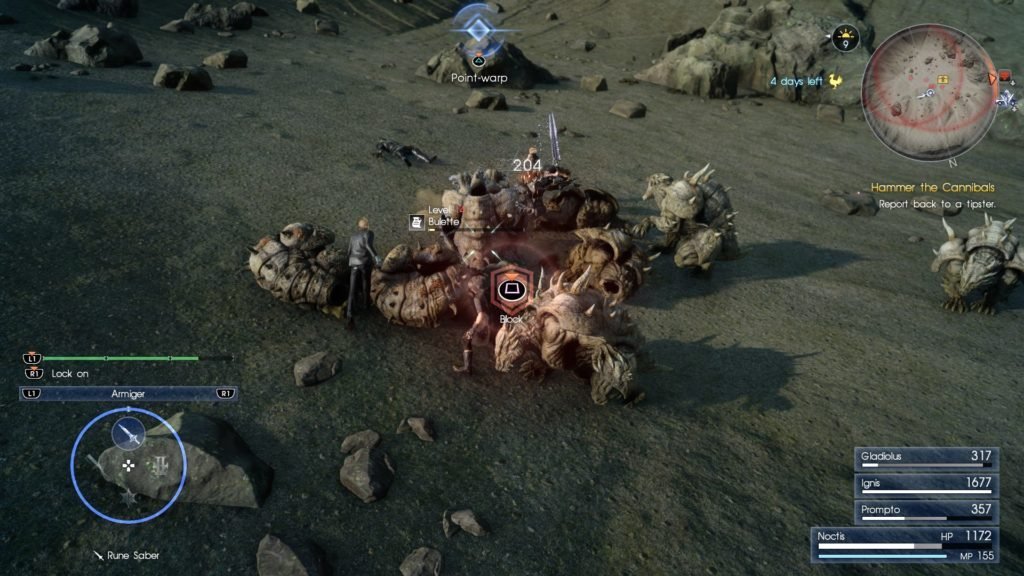
It’s a very simple foundation to begin with, and can seem almost boring at first. The complexity only reveals itself as you spend more time with it. Each fight turns into a stylish bout of positioning and timing. You deal extra damage if you can strike an enemy from behind. You can deal even more if you do it while standing next to one of your companions. Heavier attacks give you the ability to block and then parry. While lower level enemies give you plenty of time for both, higher level enemies are much less forgiving. Then Gladio, Ignis, and Prompto each have specialty skills, Techniques, you can trigger, dealing damage, debuffing enemies, or healing allies.
And that’s all before getting into the Skyrim-style, individual-category skill trees and the versatile magic-crafting system. It’s hard to place the barrier for entry much lower than holding a single button to attack. But even in doing so, Final Fantasy XV finds enough complexity to make the hours you spend in combat just as interesting as they are flashy and brutal.
That balance falters as you hit a handful of the story’s larger, more climactic boss fights however. Leaving Gladio, Ignis, and Prompto out of the action, a few boss encounters just turn into Noctis screaming as he hurdles through the air, striking at enemies while you simply hold attack button. Any sense of challenge gives way to style, making them some of the least satisfying fights of the game, even though they should be the highlights.
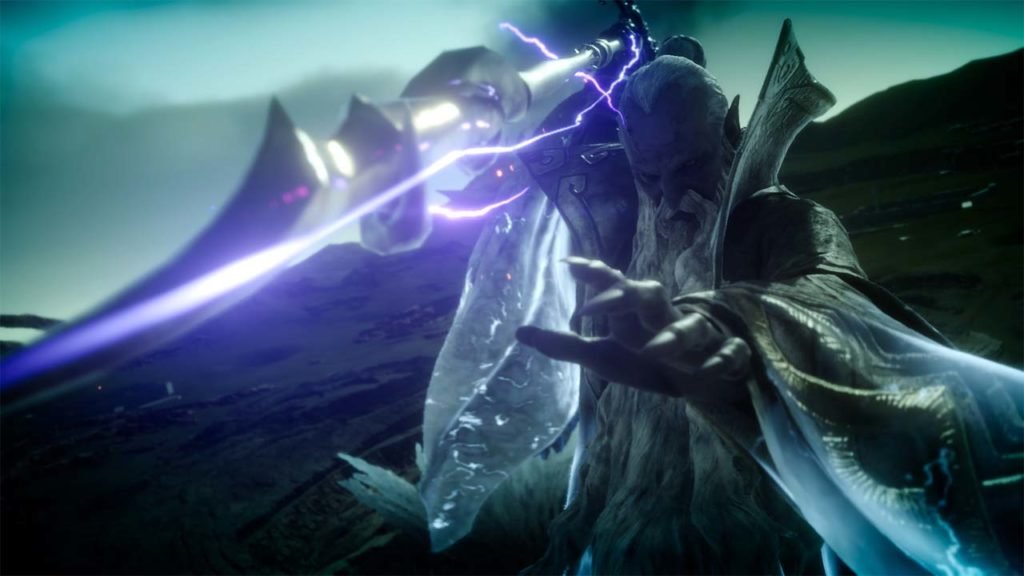
The same imbalance can be seen in the game’s summons. A key part of any Final Fantasy, summons make a return, but only as story-specific events or as random occurrences during any given fight. In Final Fantasy XV, summons are the actual gods of Eos, and every so often they will decide to help you. More often than not though, they appeared, smiting the last one or two enemies in a random mob, instead of actually providing a degree of help in the larger, more exhausting scrapes I got myself into.
Perched on top of a double-edged sword of its own, you then have the game’s open world. Beautiful and stunning, the world of Eos is worth admiring, something that Final Fantasy XV actually pushes you towards as Ignis drives you from point to point. Many aspects of the open world map are fantastic. High-level creatures roam, minding their own business until you build up the confidence to attack. You can upgrade and customize your car in various ways, and you can rent chocobos as mounts. You can accept Hunts, bounties for specific, particularly touch enemies in the world. And you can even find a number of optional dungeons to fight your way through.
Outside the main course of the game, there’s numerous side activities too. You can race chocobos, stop at an arcade machine to play the pinball-RPG mash-up Justice Monsters Five, or even place bets on monster fights in an arena. None of them compare to the depth of old fan-favorites like Triple Triad or Blitzball, but they are welcoming inclusions all the same.
That said, the open-world format also struggles. For starters, the map itself is entirely waypoint-based. Quests, dungeons, resource nodes, chests, and everything else you can think of are marked on your map. Having everything meticulously mapped out is nothing new for western open-worlds, games like Assassin’s Creed thriving on it, but it sits strangely beside Final Fantasy XV’s continued prodding to slow down and enjoy the scenery.
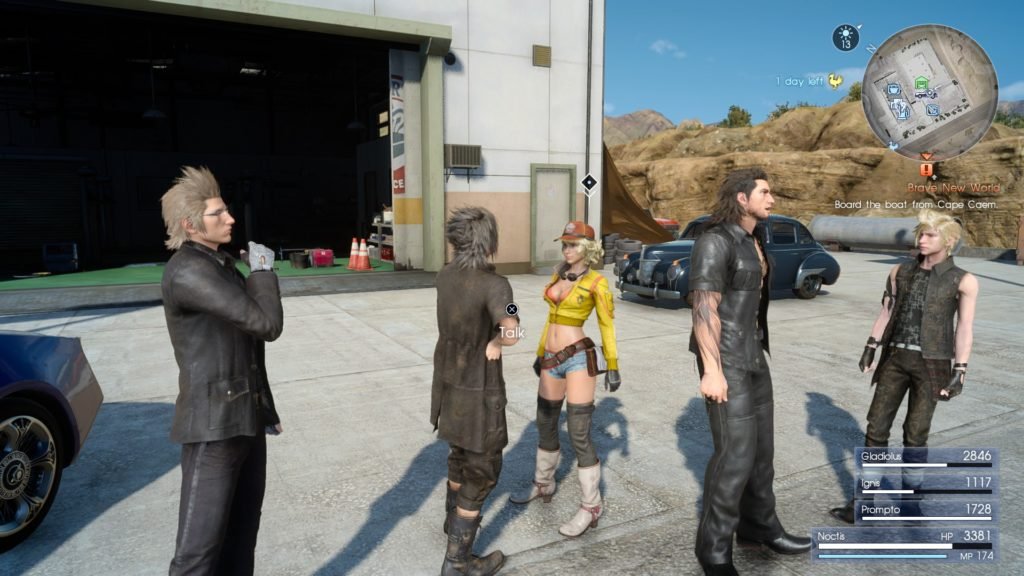
There is also the issue of the side-quests. Almost exclusively made up of fetch-quests, these multi-stage quest chains involve little more than traveling from one side of the map to the other to simply click on a single object and travel all the way back, over and over again. If it were not for the strengths of the Hunts and dungeons, some of which wait at the end of these repetitious side-quest chains, the open-world format of the game would likely have been a bust. It doesn’t help matters that many of these quest givers, such as the balloon-breasted mechanic Cindy, end up being more caricature than an interesting addition to the world.
And finally, there is the sudden change in format Final Fantasy XV undergoes in the later half of the main narrative. Shedding the open world, the game moves on to be entirely linear for the last six of its fourteen chapters. This alone isn’t a problem. The transition is well done, focuses the narrative, and delivers more than a few emotional gut punches. If you choose, you’re still able to travel back in time to the open world thanks to a magical dog (not kidding). The issue comes when this linear format goes too far.
There is a prolonged period in the later half where Noctis is alone. The fundamental strength of Final Fantasy XV, its central four characters, is sidelined. Instead, you receive multiple hours of bland, poorly executed stealth gameplay, and the most unattractive of the game’s settings: an endless maze of identical (literally the same assets used over and over), dark hallways.
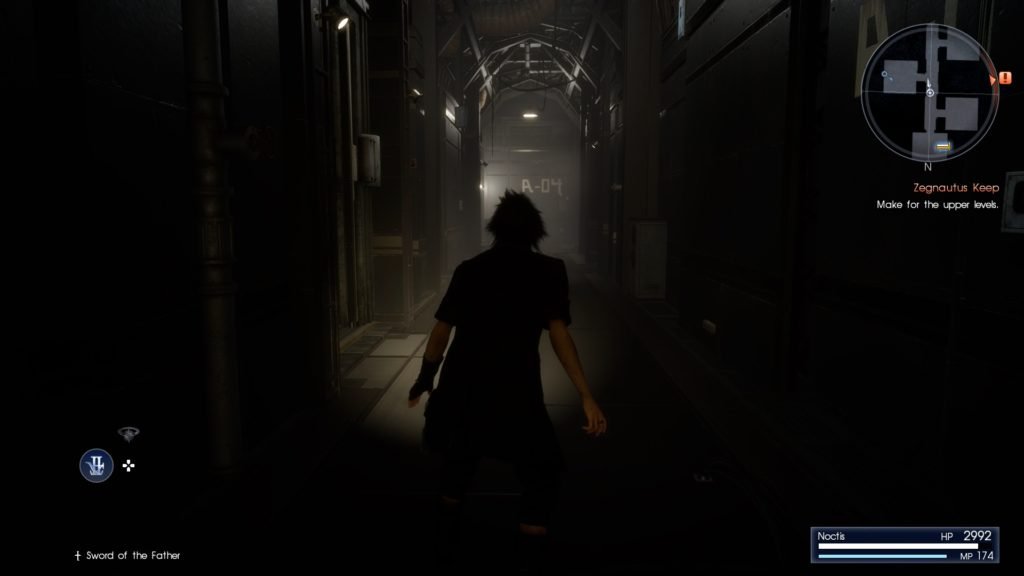
These problems mar an otherwise artful achievement of a game. It’s in spite of them that Final Fantasy XV is awe-inspiring. The combat is fun, the characters touching, and the underlying systems complex enough, without ever feeling overwhelming. And as far as raw content goes, there is more than enough to satisfy even the most veracious players. Upon completing the main story, which I did at level 51 after a little over 40 hours, there are new dungeons, Hunts, and other challenges added to keep players busy up through level 99.
Long-time, hardcore fans will likely be disappointed that the classical side of the game’s narrative isn’t better explained or explored. But those willing to look past those shortcomings will find an outstanding, vivid, and enjoyable game on the other side.
This game was reviewed on the PS4, with a copy purchased by the reviewer.
- Fun combat
- Beautiful world
- Excellent central characters
- Poorly explained story
- Far too many fetch-quest
- Any time Noctis is on his own


